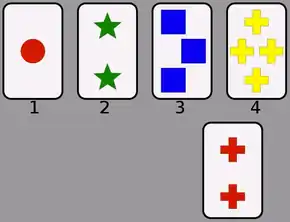Wisconsin Card Sorting Test
| Wisconsin Card Sorting Test | |
|---|---|
 Screenshot from the PEBL computerized version of the Wisconsin Card sort | |
| Purpose | measure frontal lobe dysfunction |
The Wisconsin Card Sorting Test (WCST) is a neuropsychological test of "set-shifting", i.e. the ability to display flexibility in the face of changing schedules of reinforcement.[1][2] The WCST was written by David A. Grant and Esta A. Berg. The Professional Manual for the WCST was written by Robert K. Heaton, Gordon J. Chelune, Jack L. Talley, Gary G. Kay, and Glenn Curtiss.
Method
A number of stimulus cards are presented to the participant. The participant is told to match the cards, but not how to match; however, they are told whether a particular match is right or wrong. The original WCST used paper cards and was carried out with the experimenter on one side of the desk facing the participant on the other. The test takes approximately 12–20 minutes to carry out and generates a number of psychometric scores, including numbers, percentages, and percentiles of: categories achieved, trials, errors, and perseverative errors.
Clinical use
Since 1948, the test has been used by neuropsychologists and clinical psychologists in patients with acquired brain injury, neurodegenerative disease, or mental illness such as schizophrenia.[3] It is one of several psychological tests which can be administered to patients to measure frontal lobe dysfunction. When administered, the WCST allows the clinician speculate to the following "frontal" lobe functions: strategic planning, organized searching, utilizing environmental feedback to shift cognitive sets, directing behavior toward achieving a goal, and modulating impulsive responding. The test can be administered to those from 6.5 years to 89 years of age. The WCST, relies upon a number of cognitive functions including attention, working memory, and visual processing.
The WCST may be used to help measure an individual's competence in abstract reasoning, and the ability to change problem-solving strategies when needed.[4] In this test, a number of cards are presented to the participants. The figures on the cards differ with respect to color, quantity, and shape.[5]
Psychological tests such as the WCST, administered alone, cannot be used to measure the effects of a frontal lobe injury, or the aspects of cognitive function it may affect, such as working memory; a variety of tests must be used. A participant may be good at one task but show dysfunction in executive function overall. Similarly, test results can be made misleading after testing the same individual over a long period of time. The participant may get better at a task, but not because of an improvement in executive cognitive function. They may have simply learned some strategies for doing this particular task that made it no longer a good measurement tool.[6]
References
- ↑ Monchi, O., Petrides, M. Petre, V., Worsley, K., & Dagher, A. (2001). Wisconsin card sorting revisited: Distinct neural circuits participating in different stages of the task identified by event-related functional magnetic resonance imaging. The Journal of Neuroscience, 21(19), 7733-7741.
- ↑ E. A. Berg. (1948). A simple objective technique for measuring flexibility in thinking J. Gen. Psychol. 39: 15-22.
- ↑ Banno M, Koide T, Aleksic B, et al. (2012). "Wisconsin Card Sorting Test scores and clinical and sociodemographic correlates in schizophrenia: multiple logistic regression analysis". BMJ Open. 2 (6): e001340. doi:10.1136/bmjopen-2012-001340.
- ↑ Biederam J, Faraone S, Monutaeux M, et al. (2000). "Neuropsychological functioning in nonreferred siblings of children with attention deficit/hyperactivity disorder". Journal of Abnormal Psychology. 109 (2): 252–65. doi:10.1037/0021-843X.109.2.252.
- ↑ US National Library of Medicine National Institutes of Health, 2009
- ↑ Kane, M.J. & Engle, R.W. (2002). "The role of prefontal cortex in working-memory capacity, executive attention, and general fluid intelligence: An individual-differences perspective." Psychonomic Bulletin & Review 9(4), 637-671. Retrieved from "Archived copy" (PDF). Archived from the original (PDF) on 2011-12-27. Retrieved 2011-12-31.
{{cite web}}: CS1 maint: archived copy as title (link)
Further reading
- Strauss, Esther; Sherman, Elizabeth M.; Spreen, Otfried (2006). A Compendium of Neuropsychological Tests: Administration, Norms, and Commentary. Oxford: Oxford University Press. ISBN 978-0-19-515957-8. Retrieved 14 July 2013.